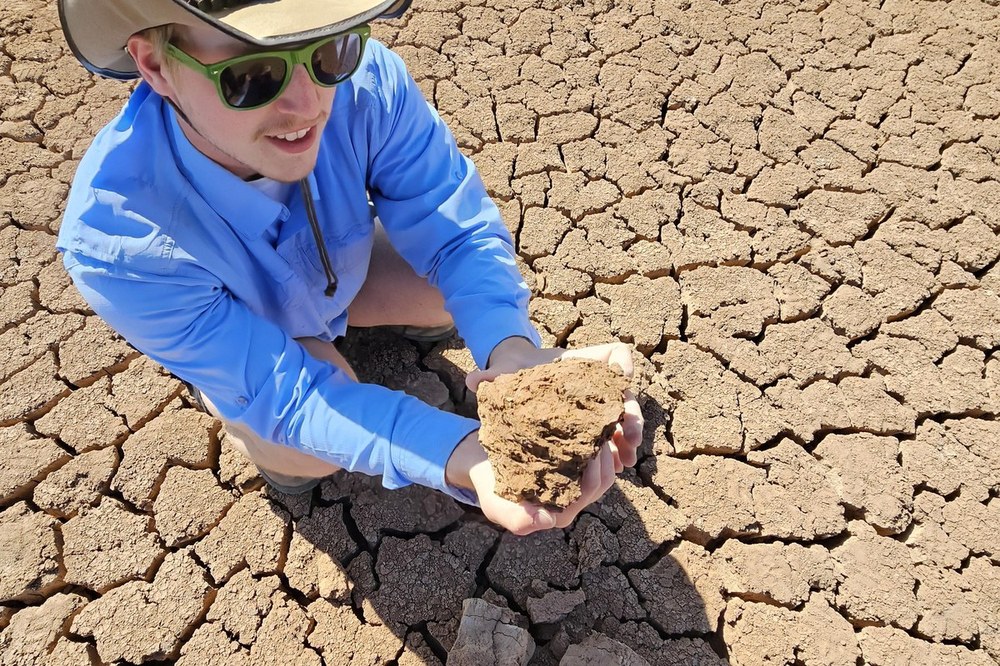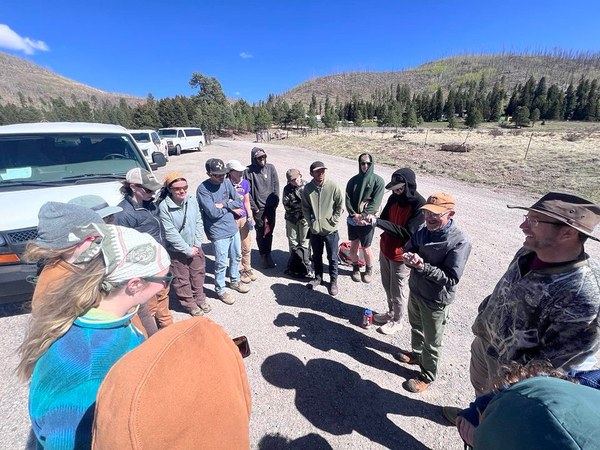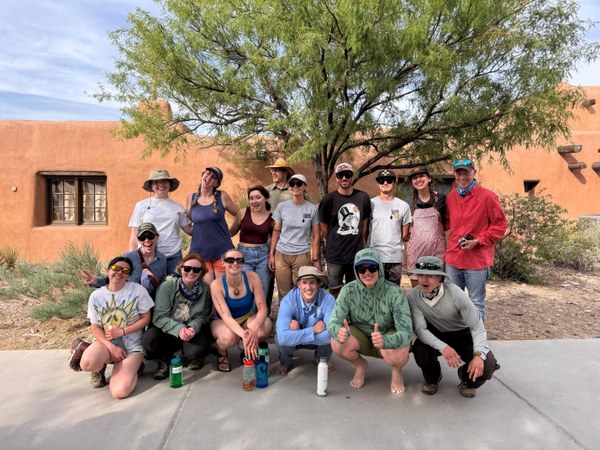Posted: June 16, 2025
Penn State and New Mexico State University students participated in a groundbreaking field course, Landscapes and Land Management of the Greater Southwestern USA, funded by a SAFES Engaged Scholarship and Experiential Learning grant. The program combined classroom instruction with a 10-day expedition across the Southwest, where students gained hands-on experience in soil science, ecosystem management, and outdoor leadership. Working alongside federal land managers, tribal communities, and leading scientists, students deepened their understanding of environmental challenges and cultural contexts. The course not only enhanced student skills and career readiness but also benefited external stakeholders through knowledge exchange, mentorship, and future workforce development.

Penn State recent Environmental Resource Management graduate, Matt Langland, examines salt-affected soils at a waterfowl wildlife management are in New Mexico
Penn State, NMSU Students Forge New Paths in Southwest Land Management Through SAFES Grant
University Park, PA & Las Cruces, NM — June 16, 2025 — With support from a SAFES Engaged Scholarship and Experiential Learning (ESEL) seed grant, Penn State and New Mexico State University (NMSU) students embarked on an immersive 10‑day field expedition across the Southwestern U.S., integrating science, leadership, and cultural awareness to confront some of the region's most pressing land‑management challenges.
The grant enabled the pilot delivery of Landscapes and Land Management of the Greater Southwestern USA, a transdisciplinary course designed to equip future land‑management professionals with field‑based technical expertise, leadership capability, and appreciation for Indigenous knowledge systems.
From Classroom to Canyons
Co‑taught by Penn State University's Dr. Patrick Drohan and New Mexico State University's Dr. Colby Brungard, the course began in spring classrooms exploring geomorphology, arid‑land ecology, fire science, and outdoor leadership. Students then journeyed May 3–12 through New Mexico, Arizona, Utah, and Colorado—studying ecosystems, soils, and federal land‑management practices at sites including Mesa Verde National Park, BLM rangelands, USFS forest lands, and Pueblo and Indigenous territories.
"The classroom setting felt like a great safe space for personal growth and vital to fleshing out the complexities of the trip region," said Penn State student Raynor Reynor. "Their connections in the scientific community allowed for the rare opportunity to meet highly‑acclaimed scientists… whose lectures and willingness to answer questions greatly improved my learning."
Those lectures included insights from renowned field soil geomorphologists such as Dr. Curtis Monger (NMSU) and Dr. Bruce Harrison (New Mexico Tech), who helped students translate textbook theory into landscape‑scale observations.
Cultivating Next‑Generation Land Stewards
Central to the experience was outdoor leadership training inspired by Jeannette Stawski's The Outdoor Leader. Students rotated through leader roles during field exercises in soil-geomorphology and camping-based activities—enhancing resilience, communication, and team cohesion.
"I really enjoyed the outdoor leadership portion of the class," said McGuire. "The lessons I have learned I have applied to other aspects of my life in outdoor leadership."
This blend of leadership and landscape science gave students confidence and clarity in pursuing environmental careers:
"I became more used to doing soil descriptions through my time out there. I learned more about how the land is managed and issues that have arisen there recently," noted McGuire.
Bridging Science, Culture, and Policy
Students had the opportunity to dialogue with federal land managers and Indigenous community leaders, deepening their understanding of complex social‑ecological intersections—water rights, tribal sovereignty, rangeland governance, wildfire recovery, and cultural heritage.
"The SOILS 497 course opened my eyes in a lot of ways. I'd never heard of most of the social issues facing the Southwest before this semester," said Penn State student Sloan Householder. "It was interesting to see how so many different issues and perspectives tied into various conflicts surrounding water rights, development, ranching, rights of Native people, and more."
Building Workforce Readiness
The grant's experiential emphasis is already paying dividends in workforce preparedness. Federal agencies—BLM, USFS, and NPS—benefited by interacting with students, mentoring them, and building stronger talent pipelines in science‑ and leadership‑centric roles.
"The field program provided an educational experience unlike any that I've had in the typical classroom setting," said Brenna Fitzpatrick. "The field portion allowed me to put my skills learned in outdoor leadership to use, as well as learn about geomorphology and soil science in the field, recognizing concepts and landforms discussed in class."
Photos and Documentation
Field experiences were visually documented for both educational outreach and stakeholder reporting. Photos capture moments such as:

Students working with USDOI Dr. Mark Miller at Valles Caldera National Preserve

Soil and landform analysis in Utah's Valley of the Gods

Course students and faculty at White Sands N.P.
Looking Ahead
The success of the pilot has spurred plans for future offerings and potential expansion. The SAFES‑supported model—combining classroom rigor, field immersion, leadership development, and cultural engagement—offers a blueprint for training 21st‑century land stewards prepared to address complex environmental challenges. The course and field program will run again Spring 2026. Students wishing to participate should submit a letter of interest to Dr. Patrick Drohan (pjd7@psu.edu) explaining why they wish to participate and include 3 references.

